In order to generate a more inclusive dataset of Pseudomonas genes mapped to putative in-paralogs and putative orthologs in other Pseudomonas species/strains, we developed a Pseudomonas Orthologous Groups classification system.
To generate ortholog groups, pair-wise DIAMOND searches were run on all genomes in the database to find reciprocal best hits (RBHs) for each gene. These analyses often resulted in multiple candidate genes for RBH status, which were narrowed down by examining the similarity between the query's flanking genes and the hit's flanking genes. If two candidate genes were directly adjacent, they where both accepted as RBHs that involve putative in-parology.
Pairwise intra-genome DIAMOND searches were also performed to acquire in-paralog information (i.e. gene duplications occurring after species divergence). If two genes in one genome were reciprocally more similar to each other than to any gene in the other genomes, the two genes were designated putative in-paralogs. Ortholog groups are built by starting with a seed gene and then adding all genes to which there is a RBH or in-paralog relationship.
Every new gene added to an ortholog group was then treated as a seed gene and the addition process was repeated until all qualifying genes had been added. The result was the development of orthologous groups, specifically generated for Pseudomonas species genomes, which can be used to sort search results.
Pseudomonas Ortholog Group POG003111
| Strain | Locus Tag | Description | Same-Strain Members | Fragment ? | |
|---|---|---|---|---|---|
| Pseudomonas aeruginosa PAO1 (Stover et al., 2000) | PA2425 |
PvdG
pvdG |
2 same-strain members: PA2411 PA2425 |
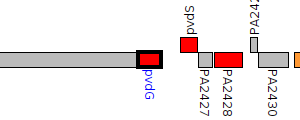
|
|
| Pseudomonas aeruginosa PAO1 (Stover et al., 2000) | PA2411 |
probable thioesterase
|
2 same-strain members: PA2411 PA2425 |
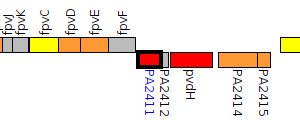
|
|
| Pseudomonas aeruginosa UCBPP-PA14 (Lee et al., 2006) | PA14_33270 |
protein PvdG
pvdG |
2 same-strain members: PA14_33270 PA14_33520 |
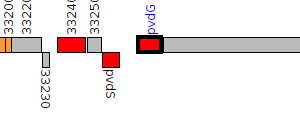
|
|
| Pseudomonas aeruginosa UCBPP-PA14 (Lee et al., 2006) | PA14_33520 |
thioesterase
|
2 same-strain members: PA14_33270 PA14_33520 |
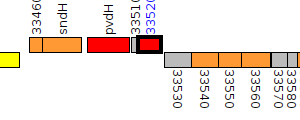
|
|
| Pseudomonas aeruginosa PA7 | PSPA7_2828 |
thioesterase
|
2 same-strain members: PSPA7_2828 PSPA7_2848 |

|
|
| Pseudomonas aeruginosa PA7 | PSPA7_2848 |
putative thioesterase
|
2 same-strain members: PSPA7_2828 PSPA7_2848 |

|
|
| Pseudomonas syringae pv. tomato DC3000 (Buell et al., 2003) | PSPTO_2134 |
pyoverdine synthetase, thioesterase component
|
1 member |

|
|
| Pseudomonas fluorescens SBW25 | PFLU4388 |
putative thioesterase
pvdG |
1 member |
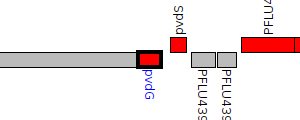
|
|
| Pseudomonas savastanoi pv. phaseolicola 1448A | PSPPH_1910 |
pyoverdine synthetase, thioesterase component
|
1 member |
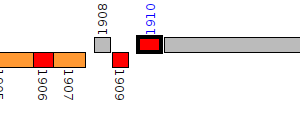
|
|
| Pseudomonas aeruginosa LESB58 | PALES_28851 |
putative thioesterase
|
2 same-strain members: PALES_28701 PALES_28851 |
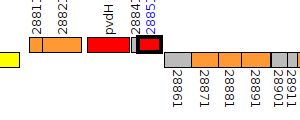
|
|
| Pseudomonas aeruginosa LESB58 | PALES_28701 |
PvdG
pvdG |
2 same-strain members: PALES_28701 PALES_28851 |

|
|
| Pseudomonas protegens Pf-5 | PFL_4097 |
thioesterase
|
1 member |
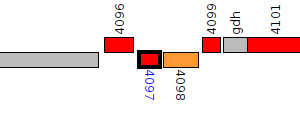
|
|
| Pseudomonas aeruginosa 19660 | Q010_02057 |
PvdG
|
2 same-strain members: Q010_02057 Q010_02071 |

|
|
| Pseudomonas aeruginosa 19660 | Q010_02071 |
putative thioesterase
|
2 same-strain members: Q010_02057 Q010_02071 |

|
|
| Pseudomonas aeruginosa 19BR | IAI_RS0112775 |
putative thioesterase
|
2 same-strain members: IAI_RS0112775 IAI_RS0112850 |

|
|
| Pseudomonas aeruginosa 19BR | IAI_RS0112850 |
protein PvdG
|
2 same-strain members: IAI_RS0112775 IAI_RS0112850 |
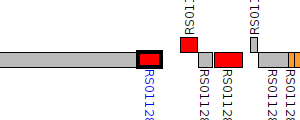
|
|
| Pseudomonas aeruginosa 213BR | IAK_RS0112960 |
putative thioesterase
|
2 same-strain members: IAK_RS0112960 IAK_RS0113035 |
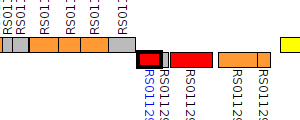
|
|
| Pseudomonas aeruginosa 213BR | IAK_RS0113035 |
protein PvdG
|
2 same-strain members: IAK_RS0112960 IAK_RS0113035 |

|
|
| Pseudomonas aeruginosa 2192 | PA2G_01514 |
hypothetical protein
|
2 same-strain members: PA2G_01514 PA2G_01536 |
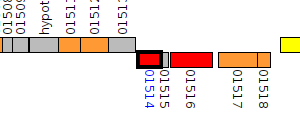
|
|
| Pseudomonas aeruginosa 2192 | PA2G_01536 |
PvdG
|
2 same-strain members: PA2G_01514 PA2G_01536 |

|